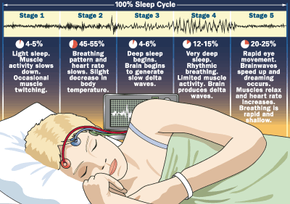If you attach an electroencephalograph to a person's head, you can record the person's brainwave activity. An awake and relaxed person generates alpha waves, which are consistent oscillations at about 10 cycles per second. An alert person generates beta waves, which are about twice as fast.
During sleep, two slower patterns called theta waves and delta waves take over. Theta waves have oscillations in the range of 3.5 to 7 cycles per second, and delta waves have oscillations of less than 3.5 cycles per second. As a person falls asleep and sleep deepens, the brainwave patterns slow down. The slower the brainwave patterns, the deeper the sleep — a person deep in delta wave sleep is hardest to wake up.
REM Sleep and Dreaming
At several points during the night, something unexpected happens — rapid eye movement (REM) sleep occurs. Most human beings experience three to five intervals of REM sleep per night, and brainwaves during this period speed up to awake levels.
If you ever watch a person or a dog experiencing REM sleep, you will see their eyes flickering back and forth rapidly. In many dogs and some people, arms, legs and facial muscles will twitch during REM sleep. Periods of sleep other than REM sleep are known as NREM (non-REM) sleep.
REM sleep is when you dream. If you wake up a person during REM sleep, the person can vividly recall dreams. If you wake up a person during NREM sleep, generally the person will not be dreaming.
You must have both REM and NREM sleep to get a good night's deep sleep. A normal person will spend about 25 percent of the night in REM sleep, and the rest in NREM. A REM session — a dream — lasts five to 30 minutes.
Medicine can hamper your ability to get a good night's sleep. Many medicines, including most sleeping medicines, change the quality of sleep and the REM component of it.



